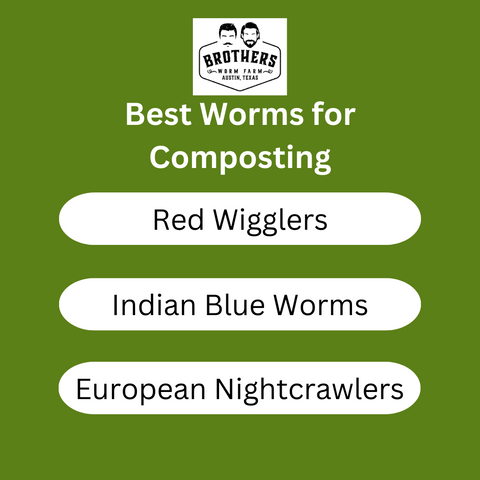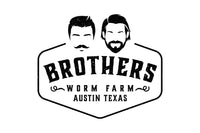
What are the Best Worms for Composting - Red Wigglers, Indian Blues, & Nightcrawlers
Composting with earthworms is a great way to recycle food scraps, yard debris, and manure, but what are the best worms for composting and vermicomposting?
In this guide we'll cover the 3 main composting worms along with their key traits and the important facts to know about each worm before you buy!
What are the Best Worms for Composting?
The best worms for composting are Red Wigglers (Eisenia Fetida), Indian Blues (Perionyx Excavatus), and European Nightcrawlers (Eisenia Hortensis). These 3 species are all great composters that work well in indoor and outdoor environments and are easy to manage. Their main differences are in size and ideal temperature range. We give a nod to the Red Wiggler as the best worm for composting due to its hardiness, appetite, and ability to thrive in a wider range of conditions than other species.
Red Wigglers and Indian Blues are very similar (as in almost identical and hard to tell apart), and although the Red Wiggler is slightly more adaptable to certain conditions, this is more than offset by the Blue worm’s ability to compost more waste and breed faster (which leads to more worms in your compost bin, more waste processed, and more worm castings for your home and garden!).

Looking to buy compost worms? Check out our red wigglers for sale and European Nightcrawlers for sale.
Characteristics of Red Wigglers, Indian Blues, & Nightcrawlers
Before making a decision on the best type of worm to use for vermicomposting, it’s important to know more about how each species operates.
Red wigglers and Indian Blues are epigeic worms, meaning they live, breed and eat within 2-3 inches of the soil surface.
Nightcrawlers, by contrast, are anecic worms, meaning they burrow horizontally and live much deeper in the soil.
The tendency of Red Wigglers and Indian Blues to live in or around the surface is 1 reason why they are one of the best worms for vermicomposting.
Most indoor and outdoor worm bins are set-up so that food is placed on the surface of the bin (where Red Wigglers and Indian Blues naturally live and breed).
Nightcrawlers, on the other hand, prefer deeper areas to burrow where they eat and breed. Nightcrawlers perform fine on the surface, but they are not as hardy as the other 2 species and this can cause more issues when surface temperatures are too hot for their survival.
Best Worms for Composting - Deep Dive
Let’s do a deeper review of the 3 main options in the best worms for composting category.
Red Wigglers
Red wigglers (Eisenia Fetida) are the most popular compost worm in North America for good reason. They can process organic matter quickly, they breed well, and they can live and thrive in a variety of conditions that harm other species.

Red Wigglers are similar in size to Blue Worms - they are on average slightly shorter than blue worms but thicker in diameter. Red Wigglers also have more pronounced, raised clitellums (the muscular ring around their neck) after mating.
Indian Blue Worms
Indian Blues (Perionyx Excavatus) are a good compost worm - they are more active than Red Wigglers and process waste and breed as well as their red cousins. They are comfortable in temperature ranges of around 45-85 degrees Fahrenheit.
It is often hard to tell the difference between a blue worm and a Red Wiggler. Blue worms tend to be skinnier and slightly longer than Red Wigglers, and they move in a faster, more jerky motion.
Blue worms sometimes get a bad rap in the vermicomposting space as they can be more finicky (e.g., leave the bin) than Red Wigglers. This is usually due to issues with temperature or ph in the bin.
In some cases, blue worms will die off (without much notice other than a declining worm population) if temperatures get and stay above 90 degrees.
That said, blue worms are not a bad option for at home composting, but it's important to know they are a bit more tempermental and less hardy than their red wiggler counterpart.

Nightcrawlers (European)
Nightcrawlers (Eisenia Hortensis) are larger earthworms that are great at processing waste but are more sensitive to temperature and soil pH than Red Wigglers and Indian Blues.

As mentioned above, nightcrawlers burrow horizontally and live and breed deeper in the soil than other compost worm species. For this reason, nightcrawlers are best suited for vermicomposting in a compost pile or windrow.
Best Composting Worms Key Traits & Characteristics
Here’s a quick summary of the red wigglers, Indian Blues, and European nightcrawlers and their characteristics:
|
Worm |
Size |
Key Traits and Notes |
|
Red Wiggler |
2-4 inches (L) ⅛ inch (D) |
|
|
Indian Blue |
3-5 inches (L) 1/12 in (D) |
|
|
European Nightcrawler |
3-8 inches (L) ¼ in (D) |
|
Best Worms for Composting - Frequently Asked Questions
Can red wigglers, Indian blues, and nightcrawlers live together in a worm bin?
Yes! All 3 species can co-exist happily in a worm bin or vermicompost pile.
How do you introduce worms to compost?
To introduce worms to compost, simply place the worms on the surface of the compost pile. Worms do not like sunlight so they will quickly burrow into the compost and find a location to begin composting. Make sure the compost is moist as worms need moist but not too wet conditions to survive.
How long does it take to get compost from worms?
Worms will begin eating and making compost as soon as they are introduced to a worm farm or compost pile. Worms consume around 1/3 of their weight every few days, so 3 lbs of worms can generate around 1 pound of compost every few days. The actual amount of compost can vary by season and conditions in the worm bin.
How much compost will 1000 worms make?
1000 worms will make around 5-6 ounces of compost every few days. Worms' ability to process organic matter depends on factors like feedstock used, moisture content in the worm bin, and ambient temperatures, so the actual compost 1000 worms will make will vary based on the season and conditions in their worm farm.
Are red wigglers or nightcrawlers better for composting?
Red wigglers are generally considered a better choice than nightcrawlers for vermicomposting. The main reason for this is that red wigglers thrive and survive in a broader temperature range than nightcrawlers, which makes the red wigglers a more reliable and consistent composter than their nightcrawler cousin.
How many worms do I need to start composting?
As a general rule, 1/2 to 1 lb of worms per square feet of worm bin space is a good benchmark for how many worms you will need to start composting. Worms will compost around 1/3 of their weight every few days, so to process 1/2 pound of food each day you will need 1-2 lbs of compost worms.
However, we don’t recommend starting with that amount until you have the hang of things.
For an indoor worm bin with 2-3 square feet of bin space, we recommend starting with 1/2 to 1 pound of worms. For outdoor bins or piles, we recommend starting with 1-2 lbs. In both cases the worms should breed and expand their population over time.
How much food will compost worms eat per day?
A good rule of thumb for how much food compost worms eat per day is ⅓ the weight of your worm population every few days. So if you start with 1 lb of worms, 5-6 ounces of food every 2-3 days should work great.
That said, worm farming is part art - we recommend monitoring the worms' eating and adjust accordingly. If the worms are finishing the food in 24 hours then increase the amount per feeding. If it is taking 4-5 days for the worms to finish the food, then feed a little less in subsequent feedings.
What worms speed up compost?
All compost worms will speed up composting, and the most common worm species used are red wigglers, Indian blues, and European nightcrawlers. All 3 species are excellent composters and differ slightly by size, breeding ability, and ideal temperature ranges.
Where can I purchase compost worms online?
Compost worms can be purchased online, or in some cases at garden centers or grow shops in your area. At Brothers Worm Farm we have red wiggler compost worms for sale in a variety of sizes.
Thanks for reading! If you have questions about this "Best Worms for Composting" blog post, or vermicomposting in general, comment below or feel free to send us an email at highfive@brotherswormfarm.com. Happy farming!!
Comments
I have to compost tumblers that I would like to add worms to do I need to separate the worms when I put that compost in the garden. And how do I do that to keep the worms going in the tumblers. Or should I use a different route for keeping the worms out of the yard and stay in the garden
What would be the approximate weight of 500 red wigglers.
I am very interested in a worm bin for composting. Pls explain to me what are dillies worms. A fishing friend says they are baby worms that he uses to fish with. Are they a separate variety? Or are they just a juvenile red worm?
I’m just starting my bin and I went fishing and bought 5boxes of red worms but didn’t use most of them so I started a bin what I don’t understand is I’m mixing all my stuff in a 5gallon bucket then adding it to my bin as they eat it and keep turning the 5gallon bucket I ad leaves scraps grass all the things I see they like or is good for them should I keep lid of bucket while I wait to feed it to them and how long will it last I only have maybe 100 worms in a small freezer I found I’m going to order some from you but I just want to make sure I can even do this if you can email me at pughsammie@icloud.com thank you for any help with this matter sammie

